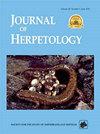Sexually Dimorphic Biofluorescence of the Postcloacal Gland in the Terrestrial Salamander, Plethodon cinereus
IF 0.8
4区 生物学
Q3 ZOOLOGY
引用次数: 0
Abstract
Abstract. Recent research has documented widespread biofluorescence across amphibians. Among caudates in particular, representative species from 8 of the 10 families fluoresce under blue light excitation. Although fluorescence has been reported on the ventral surface of the tail in Eastern Red-backed Salamanders, Plethodon cinereus, nothing is known about the source or function of the fluorescence. This fully terrestrial salamander species has a broad geographic range, has complex mating behavior involving chemosensory and visual behaviors, defends territories from conspecific and heterospecific intruders, and is a model organism for studying many aspects of sociobiology. Our goal was to learn more about the source of fluorescence in P. cinereus and to explore demographic patterns of fluorescence. Additionally, we wanted to establish whether there is seasonal and geographic variation in fluorescence in this widespread salamander species. Through our examination of histological literature and close examination of photos of the ventral surface of tails under both white and UV light, we concluded that S1 glands, which comprise the postcloacal gland (PCG) in P. cinereus, are the source of fluorescence on the ventral portion of the tail. We found this trait to be highly sexually dimorphic, with males having significantly more fluorescent S1 glands both across seasons and localities compared to females. Additionally, we found that fluorescence only occurs in adult salamanders. Further, because the ventral surface of the tail is exposed during courtship and during territorial disputes, we hypothesize that male fluorescence of the PCG may function in the context of both mate choice and territoriality.陆生蝾螈球后腺的性别二形生物荧光
摘要最近的研究记录了两栖动物广泛的生物荧光。特别是在尾两栖动物中,10 个科中有 8 个科的代表性物种在蓝光激发下会发出荧光。尽管有报道称东部红背蝾螈(Plethodon cinereus)尾部腹面有荧光,但对荧光的来源和功能却一无所知。这种完全陆生的蝾螈物种地理分布广泛,具有复杂的交配行为,包括化学感觉和视觉行为,防御同种和异种入侵者的领地,是研究社会生物学许多方面的模式生物。我们的目标是进一步了解 P. cinereus 的荧光来源,并探索荧光的种群模式。此外,我们还想确定这种广泛分布的蝾螈物种的荧光是否存在季节性和地域性差异。通过对组织学文献的研究,以及在白光和紫外光下对尾部腹面照片的仔细观察,我们得出结论认为,S1腺体是尾部腹面荧光的来源,而S1腺体构成了珠尾后腺体(PCG)。我们发现这一特征具有高度的性别二态性,雄性在不同季节和地点的 S1 腺荧光都明显多于雌性。此外,我们还发现荧光只出现在成年蝾螈身上。此外,由于尾部腹面在求偶和争夺领地时暴露在外,我们推测雄性PCG的荧光可能在择偶和争夺领地时都起作用。
本文章由计算机程序翻译,如有差异,请以英文原文为准。
求助全文
约1分钟内获得全文
求助全文
来源期刊

Journal of Herpetology
生物-动物学
CiteScore
1.60
自引率
0.00%
发文量
45
审稿时长
6 months
期刊介绍:
The Journal of Herpetology accepts manuscripts on all aspects on the biology of amphibians and reptiles including their behavior, conservation, ecology, morphology, physiology, and systematics, as well as herpetological education. We encourage authors to submit manuscripts that are data-driven and rigorous tests of hypotheses, or provide thorough descriptions of novel taxa (living or fossil). Topics may address theoretical issues in a thoughtful, quantitative way. Reviews and policy papers that provide new insight on the herpetological sciences are also welcome, but they must be more than simple literature reviews. These papers must have a central focus that propose a new argument for understanding a concept or a new approach for answering a question or solving a problem. Focus sections that combine papers on related topics are normally determined by the Editors. Publication in the Long-Term Perspectives section is by invitation only. Papers on captive breeding, new techniques or sampling methods, anecdotal or isolated natural history observations, geographic range extensions, and essays should be submitted to our sister journal, Herpetological Review.
 求助内容:
求助内容: 应助结果提醒方式:
应助结果提醒方式:


